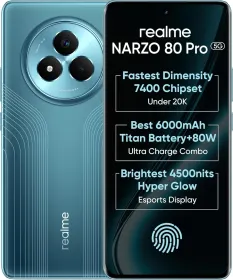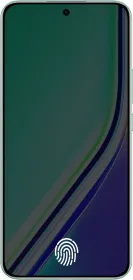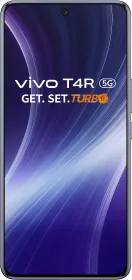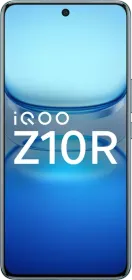In the last few weeks, we’ve seen the launch of several mid-range smartphones, including the realme Narzo 80 Pro and the Moto Edge 60 Fusion (review). Given that both the phones feature the Dimensity 7400 (4nm) SoC and cost the same for the 256GB storage variant, it only makes sense to compare the handsets for our beloved readers.
So, here’s a detailed comparison between the mid-rangers, including the differences in their dimensions, display, performance, storage, cameras, battery, and connectivity options. Without any further ado, let’s get right into it.
realme Narzo 80 Pro vs. Moto Edge 60 Fusion: Tech Specs
| realme Narzo 80 Pro | Moto Edge 60 Fusion | |
| Dimensions | 162.8 x 74.9 x 7.6 mm | 161 x 73 x 8.0 mm (or 8.3 mm) |
| Weight | 179 grams | 177.5 grams (or 180 grams) |
| Color | Speed Silver, Racing Green | Pantone Slipstream, Pantone Amazonite, Pantone Zephry |
| IP Rating | IP69 | IP69 |
| Display | curved 6.7-inch FHD+ AMOLED screen | quad-curved 6.7-inch pOLED screen |
| Processor | Dimensity 7400 (4nm) SoC | Dimensity 7400 (4nm) SoC |
| Software | realme UI 6.0 | Hello UI |
| Camera | Rear: 50MP + 2MP Front: 16MP | Rear: 50MP + 13MP Front: 32MP |
| Battery Capacity | 6,000 mAh Si/C | 5,500 mAh |
| Charging Speed | 80W wired charging | 68W wired charging |
realme Narzo 80 Pro vs. Moto Edge 60 Fusion: Design
Dimensions & Weight

- realme Narzo 80 Pro: 162.8 x 74.9 x 7.6 mm; 179 grams
- Moto Edge 60 Fusion: 161 x 73 x 8.0 mm (or 8.3 mm); 177.5 grams (or 180 grams)
The Narzo 80 Pro is noticeably thinner and lighter than the Edge 60 Fusion.
Materials
Both phones have a plastic back, except the Edge 60 Fusion’s eco-silicone polymer back variant. Both phones have a glass front, but only Moto specifies it to be the Gorilla Glass 7i.
Design

In terms of design, both the phones have a punch-hole curved screen on the front (with near-symmetrical bezels).
On the back, the Narzo 80 Pro has a circular camera array in the center, while the Edge 60 Fusion houses the camera sensors on a square-shaped island that emerges from the back panel.
Colors
- realme Narzo 80 Pro: Speed Silver, Racing Green
- Moto Edge 60 Fusio: Pantone Slipstream, Pantone Amazonite, Pantone Zephry
IP Rating
The Narzo 80 has an IP69 dust and water resistance rating and complies with the MIL-STD-810H for usage in harsh environments.
The Moto Edge 60 Fusion also features an IP69 rating and provides military-grade (MIl-STD-810H) durability.
Also Read: Galaxy Tab S10FE vs. iPad 11th Gen (2025): Which Is The Better Tablet For You?
realme Narzo 80 Pro vs. Moto Edge 60 Fusion: Display

Shining bright on the Narzo 80 Pro is a curved 6.7-inch FHD+ AMOLED screen (what the company calls HyperGlow eSports screen) that supports a refresh rate of 120Hz (240Hz touch sampling rate), resolution of 2392 x 1080 pixels (391 ppi) and 1400 nits HBM and 4500 nits peak brightness.
For a comfortable viewing experience, the Narzo 80 Pro’s screen also offers 3840Hz PWM dimming. It also covers 100% of the DCI-P3 color gamut.
On the other hand, the Moto Edge 60 Fusion features a quad-curved 6.7-inch pOLED screen that also supports a 120Hz refresh rate (300Hz touch sampling rate), has a resolution of 2712 x 1220 pixels (446 ppi), and 1400 nits HBM and 4500 nits HDR peak brightness.

Additional features of the screen include support for HDR10/10+ formats, 100% coverage of the DCI-P3 color space, and certifications from SGS for blue light reduction and motion blur reduction. The Edge 60 Fusion also supports Aqua Touch (for improved screen accuracy when the screen is wet).
While it is difficult to differentiate between the handsets’ screens, the Narzo 80 Pro supports PWM dimming, while the Edge 60 Fusion has a sharper display. Even so, both phones have an under-display fingerprint scanner.
realme Narzo 80 Pro vs. Moto Edge 60 Fusion: Performance

Underneath their shiny exterior, both the Narzo 80 Pro and the Edge 60 Fusion run on the MediaTek Dimensity 7400 (4nm) SoC, with four 2.6GHz performance cores and four 2.0GHz efficient cores, and the Mali-G615 MC2 GPU.
On the realme Narzo 80 Pro, the chipset is paired with up to 12GB of LPDDR4X RAM and 256GB of UFS 3.1 storage (128GB of storage on the base variant). Even though the Edge 60 Fusion offers up to 12GB of LPDDR4X RAM, it comes with 256GB of UFS 2.2 storage on both variants (which is significantly slower than the UFS 3.1 storage).
Though the Moto handset doesn’t feature faster storage, it allows buyers to expand the storage via a microSD card. In benchmarks, the realme Narzo 80 Pro comes out on top by scoring around 710K points on AnTuTu 10, while the Edge 60 Fusion scores around 695K points, but only by a slight margin. The similarity in performance is also reflected in the GeekBench 6 scores.

Moreover, the Dimensity 7400 (4nm) SoC is suitable for everyday tasks like browsing the internet, streaming videos via YouTube or everyday platforms, and running multiple apps simultaneously. When required, the chipset can also provide additional horsepower for playing demanding video games like Battlegrounds Mobile India (BGMI) or Call of Duty: Mobile at medium graphics settings.
Interestingly, the Narzo 80 Pro promises to provide 90 fps BGMI gameplay despite featuring the same chipset as the Edge 60 Fusion. Further, the phone also has a “Cyclone” VC cooling chamber to facilitate sustained performance during heavy workloads. As a result, the Narzo 80 Pro is a better option for gaming enthusiasts.
Also Read: Infinix Note 50X vs. Samsung Galaxy F16: Best 5G Phone Under Rs 12,000
realme Narzo 80 Pro vs. Moto Edge 60 Fusion: Software

Out of the box, the Narzo 80 Pro runs on realme UI 6.0 based on Android 15. While the user interface ships with several refinements over its predecessor, it also offers many GenAI features, including AI Eraser 2.0, AI Snap Mode, AI Ultra Clarity, AI Writer, and AI Reply.
Apart from the features, realme has promised to offer two years of major Android updates and three years of security fixes.

On the other hand, the Moto Edge 60 Fusion runs on Hello UI based on Android 15. Unlike other custom skins, Hello UI is very close to stock Android: the phone doesn’t ship with pre-installed apps either.
Besides, the phone offers several AI-based features, including Moto AI Widget, Catch Me Up, Magic Canvas, etc. Last but not least, Motorola has committed to provide three years of major Android and four years of security fixes.
While this aspect of the comparison is a bit subjective, Moto’s Hello UI provides a cleaner, bloatware-free experience. On the other hand, realme users will find the Narzo 80 Pro easier to use.
realme Narzo 80 Pro vs. Moto Edge 60 Fusion: Cameras
realme Narzo 80 Pro Camera Configuration

- Primary camera: 50MP (f/1.8) Sony IMX882 primary sensor with optical image stabilization
- Secondary camera: 2MP (f/2.4) depth sensor
- Front camera: 16MP (f/2.4) selfie shooter
While the Narzo 80 Pro can record 4K videos at 30 fps from its primary camera, it can only shoot 1080p videos at 30 fps from the selfie camera. Besides, the camera offers features like Portrait Shots, AI Snap Mode (which can capture at 1/19520sn for capturing objects in motion), Night Mode, Motion Deblur, Best Face, etc.
Moto Edge 60 Fusion Camera Configuration

- Primary camera: 50MP (f/1.9) Sony LYTIA 700C primary camera with optical image stabilization
- Secondary camera: 13MP (f/2.2) ultrawide camera with 120° field of view
- Additional sensor: A 3-in-1 Light sensor (ambient light + flicker reduction + RGB sensor)
- Front camera: 32MP (f/2.2) selfie shooter
Compared to Narzo 80 Pro, the Edge 60 Fusion allows 4K video recording (30 fps) from both the back and the front camera. Additional features include Night Vision, Adobe Scan, Portrait Video, Dual Capture Video, and Macro Vision (with the ultrawide camera).
Moreover, Motorola’s new mid-range handset provides a more versatile camera system than the realme Narzo 80 Pro.
Also Read: iQOO Neo 10R vs. Poco X7 Pro: How Do The Mid-Range Android Handsets Compare?
realme Narzo 80 Pro vs. Moto Edge 60 Fusion: Battery Life

The realme Narzo 80 Pro has a 6,000 mAh Si/C battery that supports 80W wired charging (1-50% in 21 minutes). Per the official landing page, the phone is rated to last for up to 11.7 hours of BGMI gameplay, 18.6 hours of streaming videos on YouTube, and 16.1 hours of Instagram. In addition, the battery supports bypass charging and comes with a four-year battery-health guarantee.
In contrast, the Edge 60 Fusion packs a 5,500 mAh battery that supports 68W wired charging. What’s good is that both the phones ship with a power adapter in the box, saving buyers a couple of thousand rupees.
realme Narzo 80 Pro vs. Moto Edge 60 Fusion: Connectivity

Connectivity options on the Narzo 80 Pro include 5G, dual-band Wi-Fi, Bluetooth v5,4, GPS, and a USB Type-C 2.0 port.
The Edge 60 Fusion supports 5G, Wi-Fi 6, Bluetooth v5.4, GPS, and a USB Type-C 2.0 port.
Also Read: iQOO Neo 10R Alternatives: Poco F6, Realme GT 6T, Nord 4 and more
realme Narzo 80 Pro vs. Moto Edge 60 Fusion: Price And Conclusion
realme Narzo 80 Pro Price

- realme Narzo 80 Pro (8GB + 128GB): Rs. 19,999
- realme Narzo 80 Pro (8GB + 256GB): Rs. 21,499
- realme Narzo 80 Pro (12GB + 256GB): Rs. 23,499
The realme Narzo 80 Pro has a screen similar to the Moto Edge 60 Fusion, but it sure has better CPU optimization, which is how the phone manages 90 fps gameplay on BGMI. You should also get better battery life from the handset’s 6,000 mah Si/C battery (which also supports faster charging).
Those using a realme phone for the longest time shouldn’t have much problem adapting to realme UI 6.0. All-in-all, the smartphone provides more value for its money, making it an easy recommendation for most users.
Moto Edge 60 Fusion Price

Between the two phones, the Edge 60 Fusion should provide a better software experience, including the user interface (which is close to stock Android). Motorola has committed to providing software support for longer as well.
Besides, the phone has a better camera system with an ultrawide camera that doubles as a macro shooter and a selfie camera that shoots 4K videos. In addition, the phone ships with 256GB of storage right from the base variant, making it one less thing buyers would have to worry about.
You can follow Smartprix on Twitter, Facebook, Instagram, and Google News. Visit smartprix.com for the latest tech and auto news, reviews, and guides.


































